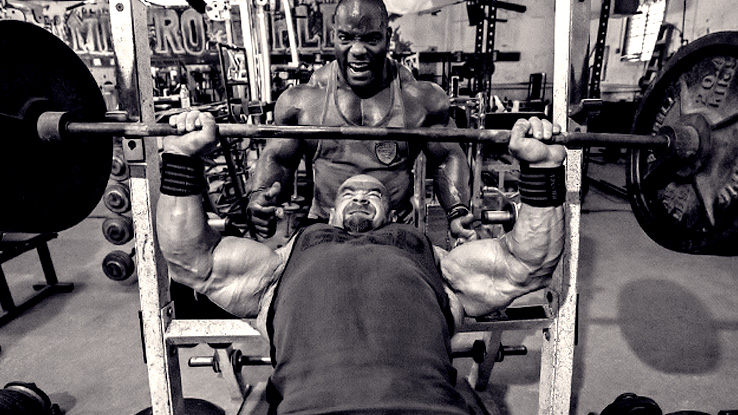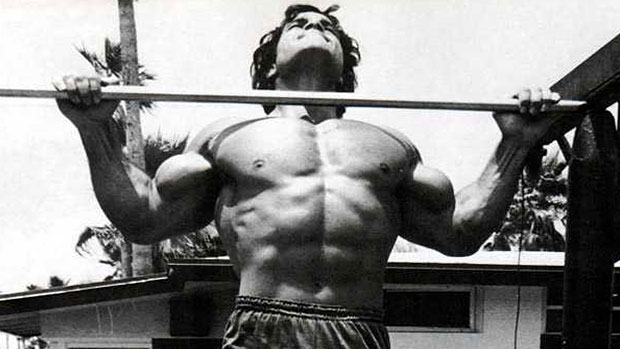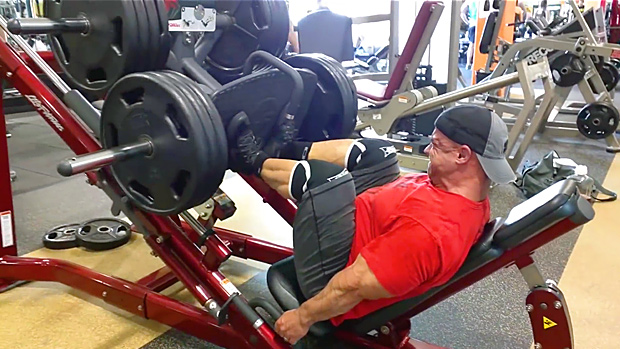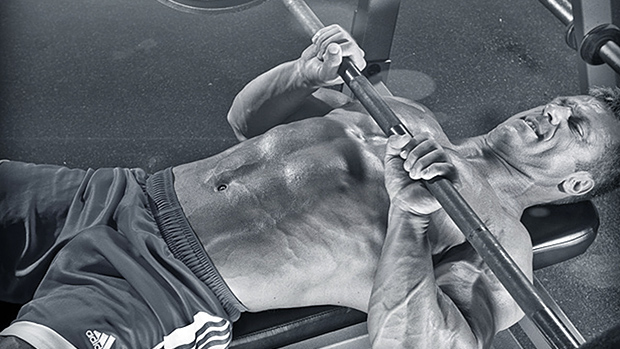Editor's Note: This isn't your
typical training article. Instead, it's more of a glimpse into
what it really takes to achieve a specific goal — in this
case a 600 pound bench press. Still, you're sure to pick up a
few training tips along the way.
Six Hundred the Hard Way
The first article I had published in T-mag was called Bench
Press 600 Pounds. In it I provided twelve tips to help you
increase your bench press, tips that took me my whole career to
learn. Although the article proved helpful to many people, benching
600 is much more difficult than I made it out to be. It's not
an easy task and for me it seemed damned near impossible as I
was stuck at 585 at the time I wrote the article.
Truthfully, the numbers are irrelevant. To some, 600 comes easy;
to others, 600 comes not at all. You can get stuck with a 300,
400, 500, 600 or even 700 pound bench press. No matter where you
get stuck there are times when the standard fixes just don't work.
You have to be willing to try many new things and change in a
moment's notice. Your sticking points can be mental, physical,
technical or a combination of all three. You only need one solution
to break a sticking point but have many options. It's somewhat
like playing the lotto. There are many numbers but only one will
win. To increase your odds you have to play as many numbers as
possible.
To illustrate, allow me to tell you the story of how I finally
benched 600 pounds, the toughest challenge I've ever had in the
sport and perhaps in life.
In the Beginning...
I entered my first competition in 1984 and benched my first 500
in the summer of 1986. I was still nineteen at the time and felt
like 600 was just around the corner. I went to work on my plan.
The first step in accomplishing this goal was to put on more muscle
mass. I weighed 242 at the time and wanted to be 275. The best
way I knew to achieve this was to go into bodybuilding.
I spent three years in the sport and even did a few shows. I
felt my strength was going through the roof. During this time
I benched 315 for a set of thirty-two reps, 405 for sets of ten,
did 405 for six on the incline press and 405 for five on the behind-the-neck
press. My off-season body weight was now at 275 and my body fat
was lower than when I weighed 242. I didn't max on my bench at
any time during these three years.
After my last show I decided it was time to go back into powerlifting
and take a shot at 600. I trained on a sixteen week progressive
overload cycle for the meet. To my surprise, on the day of the
meet I only benched 450 in the 275 pound class! What the hell
had happened to my bench? Three years of adding mass had done
nothing for me!
I was bigger and harder than I'd ever been yet I was weaker than
I was three years earlier. Lesson learned: You can't use bodybuilding
methods to get strong. Bodybuilding is fine for adding muscle
mass but you have to do specific training for the one rep range.
You also have to train with speed. This I didn't learn until years
later. My bodybuilding training was all done slowly and required
little force. Not good for benching big numbers.
I went back to the drawing board. I knew what I wanted and just
had to figure out how to get there. Over the next five years I
used my old style of training that worked for me in the past.
The first phase of the cycle I'd do sets of eight reps, then over
the next twelve to sixteen weeks the sets and reps would drop
down to one or two sets of one to three reps. During the first
two years this helped me to get my bench back up in the 500 to
520 range. Then I got stuck and nothing seemed to get me unstuck.
Instead of trying to learn more I just kept doing the same training
over and over with zero success. I learned that I had to keep
educating myself. I'd go as far as to say you have to over-learn.
Just knowing enough will only get you enough. If you want more
than enough then you'd better learn more than enough!
Louie Simmons, A Torn Pec, and Rehab
At a meet in 1990, Louie Simmons tried to sink his fangs into
me. He'd known me for a few years and had noticed how much bigger
I'd gotten. He'd also noticed that I wasn't any stronger. This
is when he asked me to make a trip to Columbus to see what they
were doing at Westside Barbell.
I made a few trips up to train with them and hated everything
I saw. It just didn't make any sense. What I did learn is that
I had to bring my triceps up. So during the next few months I
increased my total triceps volume. I felt my bench finally getting
stronger but I also felt very old. My pecs and shoulders hurt
all the time. It was hell getting through my bench training. But
even with all the pain I did feel stronger than ever. That winter
I traveled to Columbus for a bench press competition. Based on
my training (a 500 pound triple) I knew I was good for at least
a 550 to 570 max. My opener at 475 felt like crap. My second
attempt was 500. That was the attempt that tore my pec off.
I was told if I ever wanted to bench again, I'd have to get it
fixed. After surgery, they said I'd be lucky to bench 400
again. I ignored them, but I didn't ignore Louie Simmons.
He told me if I didn't change my ways I'd be out of the sport
within three years. My problems, he said, were from the heavy
progressive overload training I'd used my entire carrier. With
my arm in a sling, I told Louie about my goals. ³Listen to me,²
he said, ³and you'll bench 600.² I listened and decided
to move to Columbus.
The first challenge came during rehab. All I could think about
was snapping my damn pec off again. I became gun shy, too psychologically
freaked out to work up to the heavy weights. My head was a mess.
The other guys in the gym ragged me about it constantly and at
the time I hated every one of them for it. I even had one of them
throw tissues at me when I complained of twinges in my torn pec.
The ragging paid off of course and I became so pissed off at them
I forced myself back under the heavy weights.
The only choice was to deal with it. The more I dealt with it
the better it got. I learned that if you fear something you have
to not only stare it in the face, you have to follow through and
do it. The more times you do it the better it gets. Then one day
you realize you're no longer scared.
On the next max effort day I knew I had to deal with the demon.
On this day I figured out how to take all the fear and use it
to my advantage. I put on the bench shirt and began to work up.
When I felt like I wanted to pull out I'd think of the worst possible
situation: tearing my pec again and the bar falling on my head
and crushing my skull into pulp. I let this build until the point
where the fear was out of control. I stuffed all this fear inside
and when I got under the bar all I could think of was getting
that fucker off me. I shoved will every bit of aggression I had
and ended the day with a 550 pound bench. I was back on the path
to 600.
So Close and Yet So Far
Over the next couple of years I posted a 540, 550 and 560 bench.
My training was based on a general Westside template (see The
Periodization Bible Part II). In 1996 I benched 585 easy.
Back in the gym I just kept doing the same things I had been doing.
Over the next three years I missed 600 ten times in meets.
Now I was faced with another problem. How in the hell was I going
to get a lockout? I could jam the bar to the top but just couldn't
finish my right arm.
Then, in the summer of 1999, I decided to try on my shirt to
see how it fit. My bench felt strong so maybe I could give
600 a good ride, I thought. On my last heavy set the bar decided
to drift out to the right side about four inches and I tore off
my right pec. After an MRI I was told the decision for surgery
was up to me. The tendon was still attached but the muscle was
split almost in half.
I decided to forgo the surgery and get back to the gym. I knew
what I needed to do and started the rebab training again. The
one thing I'd learned is you have to get in the mix ASAP no matter
what the weight. So on max effort training day I still worked
up to a one rep max, although it was only 200 pounds. Maxing allowed
me to deal with the mental BS right away and get to the real issues.
Within a few months my speed work was back to normal but I was
still having trouble locking out my right arm.
Once I was back in shape I had to put the shirt on again and
see how the training was going. I worked up to 600 and missed
it three times at the top. The right arm just wouldn't lock. As
it turns out, this day would send me back to the surgeon yet again
for shoulder surgery. My teres had been torn for some time and
could've been part of the reason why the arm wouldn't lock out.
After the shoulder surgery I once again went right back to work.
Recovery from this surgery was very intense and fast. Within one
month I had my strength back but was lacking shoulder stability.
I could press fine but had a hard time setting the bar and locking
the bar out. At this point I added in some special movements to
focus on this problem. You can only fix one thing at a time so
the triceps training went on the back burner and I began a series
of shoulder movements geared toward stabilizing the joint. I used
the following shoulder complex:
1) Front raises, thumbs down
2) Front raises, thumbs up
3) Overhead dumbbell presses
4) Bent over side raise, thumb up
5) Bent over side raise, thumb down
6) Bent over front raises
7) Zottman curls
8) External shoulder rotations, bottom half
9) External shoulder rotations, top half
I used light dumbbells and performed two sets of 12 reps four
days a week at the end of every main training day. At night I'd
do 100 push-ups and lower the position each time 100 was met.
I started the push-ups standing against a wall and worked down
until I was performing these off the floor. I'd do as many reps
as I could then rest a minute or so and keep going. At first
to get all 100 would take many sets and long rest periods. Once
I was able to get 100 on the floor within ten minutes (about one
month) I dropped the push-ups.
The last movement I included was a reverse barbell shrug while
lying on the bench. I began with 95 pounds and could barely get
ten reps. I worked this movement for about six weeks and got up
to 225 for ten. At this point the shoulder joint began to stabilize
itself and the lockout was almost better than before the surgery.
In the fall of 2001 I benched 500 at a bench meet and decided
to focus again on triceps strength. I added in high board presses
with bands and a few other heavy pressing triceps type movements.
I wanted to try to use the bands for most of the partial range
max effort movements to fix my lockout problem. I needed to be
able to strain at this position for a longer period of time. I
also added in more bands on the speed day.
At a meet in the winter of 2002 I opened with 500 then went to
545. I missed to lift halfway up and decided to take it again
on my third. I switched back to a thumbless grip and managed to
make the lift. It was very sloppy and just about killed me in
the process, but I had the strength to strain and press it to
lockout. This is when I knew I had to again change many things.
First, I was always beat up and would wake up every night unable
to move my arm because of the shoulder pain and my elbows hurt
when I trained. Second, my lockout was still way off. The bar
wanted to always fly back toward the rack. Third, I was pressing
with my pecs first off the chest, not my triceps. Forth, I had
no idea what I was doing with a bench shirt. Fifth, I'd totally
lost my confidence in the bench.
I had my sites set on June with the goal of a 600 bench. I didn't
care what the total was; I just wanted to get back in the game
and needed a place to start.
The Last Push
The first thing I had to do was get healthy. To do this I used
three workouts instead of two. The two standards were one max
effort workout on Wednesday and one dynamic workout on Sunday.
I was still going to train these days but was now going to have
one max effort day, one repetition day, and one speed day.
For the max effort day nothing was going to change. The speed
day was going to be with mini bands one workout and chains the
next. The rep day was going to be a speed day with only 225 with
no bands or chains for 15 sets of three reps with 30 to 40 seconds
rest. I'd then follow this with bodybuilding work for the triceps,
lats and delts. Most of this work was strict and to failure. I
had to put muscle mass back on that I'd lost and needed it quick.
I used a lot of dumbbell presses, dumbbell raises and pulldown
work. During this time I also started getting Active Release (ART)
treatment each week.
I kept this schedule for six weeks. During this time I started
to get healthy again and some of my max effort records were getting
broken by 50 pounds. Once I felt healthy I went back to the one
max effort session and one dynamic session except for a few changes.
My max effort work kept going up to the point where I began beating
many of the 600 plus benchers on the movements. After four or
five weeks I put the shirt on again and missed a 525. Now I knew
what was wrong. My triceps were stronger but I was still pressing
with my pecs first and counting on my leg drive to get the bar
off my chest. I also had to bring more speed into the training.
Now my plan was to use bands on every speed day and set up a
circa maximal phase to bring the speed back. [Editor's note: "Circa maximal" means
using submaximal weights for a short phase.] I lowered
the bar weight to 185 for the first two to three sets with one
band. The band's weight is equal to 40 on chest and 90 at top.
I'd then jump to 205 for two more sets. If this felt good I'd
add another band for two more sets with the same weight. This
slowed the bar down but taught me to push faster. Then I'd reduce
the weight to the original 185 with one mini band for two last
sets. I called these my ³super speed sets². This was used for
a short three week cycle to prep my body for the circa-maximal
phase to follow. The circa maximal phase used for this meet is
as follows:
Week 1: Warm up
to 155 with two mini bands (band weight 80 on chest and 180
at top). Two sets were done here. I then put on two chains each
side and did three sets (chain weight 0 on chest and 80 at top).
This is a total of nine reps and was maximal for me. I then
went down to 155 with one mini for two more sets. From there
I went on to triceps, lat and delt work. I kept the triceps
work light and supersetted pushdowns with band extensions.
Week 2: Warm up
to 155 with two mini bands. Two sets were done with this weight.
I then added a mini band choked (not folded) for one set. Next
I jumped to three mini bands for three sets (band weight 120
on chest and 270 at top). These sets were slow as hell but taught
me how to lock out and think.
I've always been an aggressive bencher. By this I mean just
lay down and shove the bar. I had to learn to think throughout
the lift. With the bar moving this slow at the top I learned
how to position my elbows to finish the lift if it got too heavy.
I then went down to 155 with two mini band for two sets. The
accessory work was the same as week one. My max effort work
for this week was high rep dumbbell presses with the intention
of getting away from the heavy work and work more on restoration.
Week 3: The same
as week two except for my max effort day I did board presses
and broke my six year old record by 25 pounds.
Week 4: De-load week. I was going to use 175 with one mini band but after
the first two sets I began to feel I was going to hurt myself
because the bar was moving too fast. I put on another set of mini
bands for two more sets then did one last set with 175 and one
mini band.
I stayed with this for about four weeks. If I felt beat up I
just used 185 with one mini band and stayed there. I also began
catching the bar again. By this I mean I didn't let the bar touch
my chest. I also benched a few weeks with my feet on a crate.
This was to take my legs out and teach me to drive with the triceps
first. After the speed work I did low pin presses for three sets
of three reps. After that I went to triceps, delt and lat work.
My max effort days were the same as everyone else in the gym.
Over all this time we used board presses, floor presses, chain
presses, and reverse band presses.
At the meet I opened with 550; the weight went up like an empty
bar. I then jumped to 605 for the second. Here I was again at
the weight I'd waited so long to get. Unlike all the times in
the past, this day I had all my bases covered and the weight flew
off my chest to lockout. I went for 635 on my third, but it didn't
happen. No worries, because I know I can get it the next time.
Conclusion
Hopefully you'll find this motivating and perhaps reach your
goal without making the same mistakes I did along the way. I had
to learn a hell of a lot over the past eighteen years to break
600. I learned that as long as you keep your sites set on one
specific goal and don't give up, someday it'll be yours. It may
take longer than you think (six years for a twenty pound record
in my case) but as long as you're willing to put in the time,
listen to others and never quit, you can achieve whatever you
set your mind to.
Take it from me. I've seen it all, torn it all, heard it all,
and told myself it all over the past six years. If I can do it
then anyone can. Now get your ass back in the gym.
For more information about these methods and products visit www.elitefts.com.




